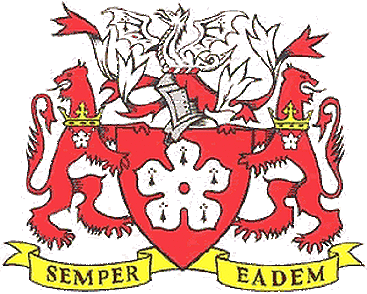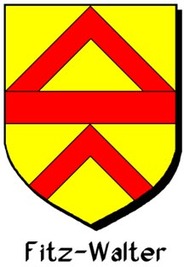
Some Arms were devised to record the incidents of feudal tenure. For example, the family of Argenton, who once held the manor of Wimondley, which required the tenant to present a cup of wine to the King at his coronation, bore three silver covered cups on a red shield. Sir John Argenton performed this service at the coronation of Richard II, and had the silver cup for his fee. As an example of early official Coats of Arms we have the silver sword on a black shield attached to the office of Hereditary Grand Champion of England. This was formerly borne by the Marmion family, whose descendant and successor to the Championship, the head of the family of Dymoke, still quarters it with his own Arms; while his motto “Pro Rege dimico” ( I fight for the King), happily combines a play upon his name with a reference to his office. The desire to suggest their name- at least the second syllable- led the ancient Dymokes to adopt as a crest “ two asses eerys grey”, a moke being an old English term for donkey.
Since Heraldry first flourished at the height of feudalism, it naturally occurred that many men acknowledged their feudal dependency by basing the Coat of Arms on those of their overlords, introducing differences of color and detail. For instance the cinquefoil ( five leaved flower) in the Fitzpernell, Earl of Leicester, Coat of Arms, image above, is also found in the Arms of several old Leicestershire families, and still forms the Arms of the city of Leicester. Three chevrons derived from the great House of Clare variously colored and sometimes borne with other charges appear in the Arms of many families that were connected with them feudally, such as the Fitzralphs, who placed three fleur-de-lis upon each chevron to differentiate. Similarities in Arms such as these may denote an ancient feudal connection between the families that bear them. It may also indicate that the families came from the same stock. For example the Arms of the Fitzwalter's, Or a fess gules between two chevrons of the same ( a gold shield with a red fess and 2 red chevrons, image below) recall that this family traced their ancestry to Robert, fifth son of Robert de Tonbridge, Earl of Clare, the Clare family having three red chevrons on a gold field.
 Towards the end of the age of chivalry, Heraldry began to reflect historical occurrences of the time. Kings and Princes began to reward the service of their followers by the grant of Arms or through augmentations- the addition of honorable emblems to existing shields. Still later, as the original purpose of Heraldry as a means of identification ceased, due to changed methods of warfare and the abandonment of complete body armor, the symbolic side of the art-science was developed to a greater extent and a large number of newly-created Coats of Arms contain some reference to the status, profession or achievements of the men to whom they are granted.
Towards the end of the age of chivalry, Heraldry began to reflect historical occurrences of the time. Kings and Princes began to reward the service of their followers by the grant of Arms or through augmentations- the addition of honorable emblems to existing shields. Still later, as the original purpose of Heraldry as a means of identification ceased, due to changed methods of warfare and the abandonment of complete body armor, the symbolic side of the art-science was developed to a greater extent and a large number of newly-created Coats of Arms contain some reference to the status, profession or achievements of the men to whom they are granted.

